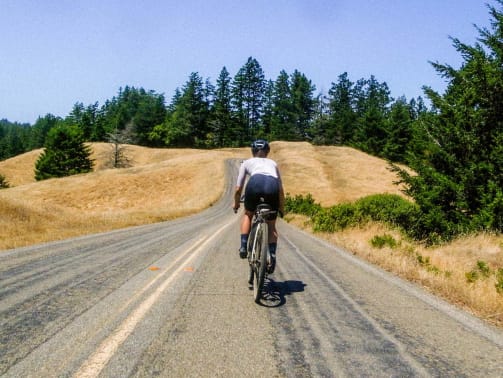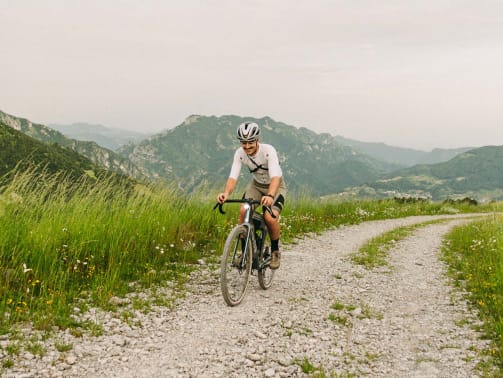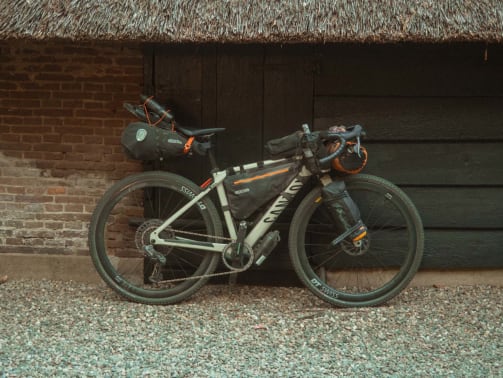Elevate your endurance: Long distance training essentials
Want to make the most of your next bikepacking adventure? Structured training will change the game for you. Here’s a guide to help you get started with your training for long distance cycling.


Bikepacking long distances is one of the most rewarding sports, often striking just the perfect level of challenge and enjoyment. You go through tremendous highs and lows, both mentally and physically. Here’s the thing though – the better you train and prepare for your endurance cycling challenge, the more you get to enjoy the challenge rather than suffer through it. ‘Sufferfest’ has its time and place but a good training plan can really help you make the most out of your grand adventure.
Sisällys
What even counts as “long distance”?
Well, how long is a piece of string? Long distance cycling can literally be anywhere from the longest distance you’ve ever gone in one go without breaks to a multi-month ride around the world. Generally speaking, anything that takes you beyond whatever is your current normal is “long”. Obviously, then you take it to the next level by signing up to something that requires you to do it day and day, or sometimes even week after week. That, right there, is basically any multi day long distance cycling event. It can really test you physically and mentally. This is where your preparation plays a huge part.
Good preparation begins with a suitable bike. Depending on the terrain that your endurance challenge will involve, you can use a road bike, gravel bike or mountain bike. The reason you want to use the bike you’ll head out on for training is so that you get accustomed to the position you’ll be riding in, make any relevant bike fit changes and truly make that bike feel like home.
If most of your route is on tarmac, go with a bike like the Endurace which has the perfect mix of comfort and speed. If your route is mixed – country roads, forest roads, and singletrack, then a gravel bike like the Grizl is more suited. For the performance efficiency of a road bike and capability of a gravel bike, a Grail is perfect. Finally, if you’re truly heading for the wilderness and most of your route is pure off-road gnar, then look no further than a cross country mountain bike like Grand Canyon or Exceed. Whichever bike you choose, make sure that it fits you well and that you’ve trained with it. Make sure that you do a few rides with your full setup to test that everything works and make any last minute changes.
The physiological foundation
If you’re obsessed with levelling up the skill and ability to do any sport and are curious about what your body and mind are capable of, you’re an endurance athlete at heart.
Training for endurance helps to prevent injuries, ride stronger and maximise enjoyment.
Specific training becomes essential beyond casual riding because long-distance cycling demands unique physiological adaptations occurring only through structured endurance work. The cardiovascular system must deliver increased volumes of oxygenated blood to working muscles, while the muscular system develops enhanced fat oxidation capabilities. Following a plan for your training can produce predictable adaptations within specific timeframes.
Still not convinced that you need to train? Here are some key benefits of training:
- Improved endurance: you can ride longer with significantly less fatigue. This means that you can explore further and actually enjoy it all.
- Enhanced recovery: you're not only building the ability to push harder but also to recover faster. Systematic training accelerates recovery through improved cardiovascular efficiency and lactate clearance.
- Greater efficiency: what got you huffing and puffing before will no longer be a problem- your new superpowers will be getting up your local nightmare of a climb and smiling the whole way up. Endurance training improves your mechanical efficiency.
- Mental Resilience: Long-distance training develops psychological capacity to push through discomfort and maintain focus during challenging conditions. This carries through outside of your training or generally outdoorsy life too.
Building an effective long distance cycling training programme
First of all, let’s begin with a clear sense of purpose: do you want to ride longer distances comfortably, prepare for a long distance gravel race or sportive, or simply feel stronger on weekend rides? Once your goal is set, the structure of training can start to take shape.
At the heart of endurance development is consistency. Riding regularly, even if sessions are shorter on busy days, builds the aerobic base your body relies on. Long, steady rides AKA ‘base miles’ help train the muscles and cardiovascular system to use oxygen more efficiently. These rides should feel sustainable. If unsure, see if you can sing your favourite song comfortably or chat with a friend while riding, not a breathless push to the limit. This conversational pace is your zone 2.
Progress then comes from gradually adding variety. Intervals at a higher intensity strengthen the heart and boost lactate threshold, allowing you to ride faster for longer without fatigue. Recovery rides, lighter in effort, flush the legs and set the stage for growth. Together, these sessions create balance: stress and rest woven carefully through each week.
Equally important is listening to your body. Endurance gains build slowly, and overtraining can quickly unravel progress. Including rest days, fuelling well with whole foods, and prioritising hydration are essential parts of the programme and not add-ons. Strength training, core work, and flexibility practices can also support the body against the repetitive strain of cycling.
Finally, progression should follow a simple rhythm: increase training load gradually, usually over three weeks, before easing back in the fourth to recover and consolidate. This cyclical approach prevents burnout while steadily moving fitness forward.
An endurance cycling programme, then, is not a rigid schedule but a living guide. With patience, variation, and attentiveness, it becomes the path to stronger legs, steadier lungs, and, most importantly, greater joy on the bike.
Progression should follow a simple rhythm: increase training load gradually, usually over three weeks, before easing back in the fourth to recover and consolidateVedangi Kulkarni

Understanding the key ride types for training
Varying your training ride ensures that you’re challenging your physiology in the right way as well as keeping things interesting! After all, we ride because we love to do so.
Here are some key ride types:
Steady endurance rides
- Purpose: Build aerobic base and fat oxidation capacity
- Intensity: Zone 2 (70-75% max heart rate), conversation pace
- Duration: 60-180 minutes
- Frequency: 2-3 times per week
Sweet spot/tempo efforts
- Purpose: Improve aerobic capacity and sustainable power
- Intensity: 88-93% FTP, challenging but sustainable. If you haven't measured your FTP (functional threshold power) yet, go with your RPE (rate of perceived exertion)
- Duration: 20-60 minutes total interval time
- Frequency: 1-2 times per week
Long slow distance sessions
- Purpose: Build endurance and practice race-day strategies
- Intensity: Zone 1-2 (60-75% max heart rate)
- Duration: 3-6+ hours
- Frequency: Once per week.
Recovery Spins
- Purpose: Promote active recovery and maintain training routine
- Intensity: Zone 1 (50-60% max heart rate)
- Duration: 30-60 minutes
- Frequency: 1-2 times per week between hard efforts
Obviously you wouldn’t expect to do all of these each week, but depending on how motivated you are, you could look to build up to this volume of training over a period of weeks and months.
Structured interval training for endurance cycling
Another excellent format way to prepare your body and mind for endurance cycling is through interval training. This can help improve efficiency, raise lactate threshold, and develop power reserves for climbs and headwinds.
First things first, figure out what your FTP is. You can use Zwift or Wahoo for this. Most training softwares out there will have a pre-loaded FTP test on them. Ideally, do this indoors. You can also do this outdoors using a power meter, but it can be challenging to find a stretch of road where you can consistently push hard without running into traffic lights, other vehicles or simply a flat enough section of road.
Once you know your FTP, here are the key interval types you can work with:
Short high-intensity intervals
- What: 30-second to 2-minute efforts at 120-150% FTP with equal recovery periods
- Why: Improve neuromuscular power and lactate buffering capacity
- Example: 6x30-second efforts with 30-second recoveries, building to 8x2-minute efforts
- How Often: Once per week during build phases
Sweet spot intervals
- What: Training at 88-93% FTP, bridging tempo and threshold zones
- Why: Maximises training stress while maintaining repeatability
- Example: 3x10-minute efforts with 5-minute recoveries, progressing to 2x20-minute efforts
- How Often: 2-3 sessions per week for time-crunched cyclists
Threshold intervals
- What: Training at 95-105% FTP to improve sustainable power
- Why: Elevates lactate threshold and develops mental stamina
- Example: 2x20-minute efforts at 95% FTP with 10-minute recovery, progressing to continuous 45-minute efforts
- How Often: 1-2 sessions per week maximum

Fuel your cycling training with optimal nutrition
You know that horrible feeling when you hit a wall and genuinely wonder if you’ll ever recover from it? Optimal nutrition can not only help avoid that but also help you so that your energy feels steady, your muscles recover smoothly, and your mind stays sharp when fatigue settles in.
Pre-ride nutrition strategy
Before you ride, your focus should be on building a reliable foundation. Complex carbohydrates such as oats, rice, or whole grains fill up your glycogen stores, while lean proteins and healthy fats keep hunger at bay and create balance. Hydration is equally crucial. Sipping water throughout the day ensures you don’t begin your session already behind. Aim to eat one to three hours before heading out for your training ride.
On-bike fuelling
During training is where you will first notice the difference fuelling makes. For efforts over 90 minutes, aim to take in a steady stream of carbohydrates, typically from easily digestible sources like bananas, energy gels, or chews. If you’re not a fan of energy gels, then you can always find more natural alternatives that provide similar levels of calorific benefits. Aim to eat small doses of something that your body is happy with every 20-30 minutes. Combine this with regular hydration, adding electrolytes if riding in the heat, to replace the sodium and minerals lost through sweat. When you fuel sufficiently, energy levels feel more stable.
Post-ride recovery
Recovery begins the moment you step off the bike. A mix of protein and carbohydrate within 30–60 minutes helps repair muscle damage and replenish depleted stores. Think of it as sealing in the gains you’ve just worked for. Beyond that window, balanced meals rich in colourful vegetables, grains, and quality proteins support long-term adaptation.
Ultimately, fuelling for endurance is a practice of listening, adjusting, and anticipating. With consistency, nutrition becomes less of a puzzle and more of a rhythm.

Essential gear for long distance cycling
The aim of the game is to keep going for a long period of time. This means that everything should not only fit well but also be comfortable.
Endurance-optimised bikes: Relaxed geometry, compliance features, wider tyre clearance. Canyon's Endurace series is perfect for endurance training and riding. The design integrates aerodynamic efficiency with comfort-oriented geometry. Check out our recommendations for best bikes for bikepacking.
Contact points: Nobody likes getting saddle sores, callouses or nerve damage from being in the same position over an extended period of time. It's always a good idea to get a bike fit, find a saddle that works for you and figure out different ways of holding your handlebars and aerobars without compromising efficiency to make your riding comfortable.
Hydration systems: Especially for long rides, make sure you have enough carrying capacity by using multiple bottle cages or using hydration packs. The running vests are normally pretty handy for cycling use.
Carrying capacity: There are a million different ways to ensure that you're carrying everything that you need with you while also ensuring that your setup is light and fast. Use purpose-built bikepacking bags like seatpost packs or Tailfin trunk bags, top tube bags, handlebar bags and food pouches.
Navigation: Make sure you have multiple ways of navigating at any given point of time, at least one of them being offline. Carry a bike computer with your planned route pre-loaded on it. You can also use several smartphone apps that allow you to navigate on-the-go and download a particular area on the app. Always carry a paper map with you even if you fully trust every single one of your devices.
Strength and flexibility training
Riding your bike more will absolutely make you strong but strength training will help you go further and prevent injuries. Here are a few simple exercises to bulletproof your body to handle the physical impacts of long distance cycling.
Core and lower body exercises
Plank variations: Front planks with walkouts develop core stability while challenging shoulder girdle strength.
Bridges: Hip bridges with leg raises target glutes and posterior chain.
Single-leg squats: Unilateral strength movements address imbalances while building functional leg strength.
Russian twists: Rotational core work improves stability during out-of-saddle efforts.
Superman planks: Alternating arm and leg extensions challenge core stability in cycling-specific patterns.
Upper body stability
Push-up variations: Develop chest, shoulder, and tricep strength while challenging core stability.
Single-arm rows: Address postural imbalances from prolonged forward-leaning positions.
Overhead press: Half-kneeling single-arm variations build unilateral strength and core stability.
Lat pulldowns: Builds back and shoulder strength and helps with posture.
Flexibility and mobility
Hip flexor stretches: Counter tightness from prolonged cycling position.
Hamstring stretches: Address posterior chain tightness. Perform both straight-leg and bent-knee variations.
Lower back stretches: Cat-cow stretches and knee-to-chest positions relieve spinal compression.

The importance of recovery in cycling training
As training volume increases, recovery becomes crucial to allow muscles, energy systems, and the nervous system to repair and adapt. Without enough recovery, accumulated fatigue can lead to performance declines and injury risk. Proper recovery ensures consistent progress and endurance capacity.
Signs of overtraining include decreased power output, chronic fatigue, persistent soreness, mood changes, and poor sleep. Preventing overtraining involves balancing ride intensity and duration with rest, listening to the body, fuelling properly, and prioritising sleep. Adding the element of active recovery within your plan promotes blood flow and muscle repair without adding strain. This helps clear metabolic waste and reduce stiffness and speeds recovery for the next hard ride.
Sleep quality directly affects endurance performance by aiding hormonal balance, muscle repair, and mental focus. Aim for 7-9 hours nightly every night with consistent sleep/wake schedules. Monitor fatigue using subjective feelings like motivation and perceived exertion, alongside objective measures such as resting heart rate or heart rate variability. Elevated RHR or low HRV can signal fatigue.
Practical tips for your first long distance bike training plan
Start by building a solid base with consistent, moderate rides that gradually increase in duration each week. Incorporate rest or active recovery days to allow your body to adapt and prevent burnout. Break longer rides into manageable segments. Focus on pacing and nutrition. Practice eating and hydrating during rides to avoid fatigue and cramps.
Training for a long distance cycling challenge is a lesson in endurance in itself, so naturally you will encounter fatigue, soreness, and mental barriers. Listen to your body and adjust intensity or rest as needed. Prepare for weather or mechanical issues by carrying essential tools and wearing appropriate clothing. If your motivation is dwindling, find yourself some training partners. Time passes quickly when you’re out with a group.
Where your journey can take you next
With a strong base, you can throw yourself into challenges head first. This training journey will teach you a lot about yourself and you will know well how your body and mind deal with the ups and downs of an endurance activity. This will make your goals seem within reach and you will really be able to enjoy the experience.
If you've got an eye on an ultra endurance road race, then take a look at Canyon's Endurace series to find the perfect bike for you. If you’ve got adventure on your mind, then take a look at how you can plan the route of your dreams. And if you’re still choosing your ideal ride, check out our road bike, gravel bike, and MTB buying guides to find the best fit for your goals.
And that’s it from us, keep these long distance training tips in mind, and we’ll see you out there on the road.
Tutustu gravelpyöriimme
Oliko tästä artikkelista apua?
Kiitos palautteestasi
-
 Tietoa kirjoittajasta
Tietoa kirjoittajastaVedangi Kulkarni
Tutustu inspiroivaan tarinaan Vedangi Kulkarnista, joka on nuorin nainen, joka on pyöräillyt yksin maailman ympäri ilman tukea. Tämä seikkailuja rakastava kestävyysurheilija, puhuja ja kirjailija on myös yrityksen omistaja ja retkikunnan johtaja. Kun hän ei ole tutkimassa maailmaa, hän sukeltaa filosofisten ja luontokirjojen kirjoittamisen pariin tai tutkii arktista aluetta.








